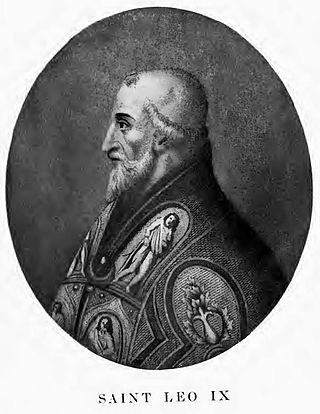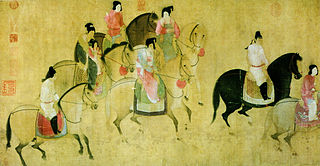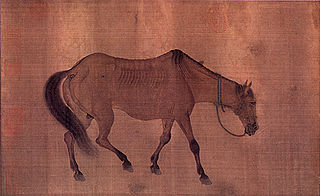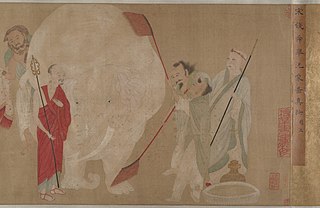Paintings

- Xu Daoning paints Fishermen's Evening Song 1049 [1]
| |||
|---|---|---|---|
| +... |
| 1030s .1040s in art. 1050s |
| Art timeline |
The decade of the 1040s in art involved some significant events.


Year 1049 (MXLIX) was a common year starting on Sunday of the Julian calendar.

Ink wash painting ; is a type of Chinese ink brush painting which uses washes of black ink, such as that used in East Asian calligraphy, in different concentrations. It emerged during the Tang dynasty of China (618–907), and overturned earlier, more realistic techniques. It is typically monochrome, using only shades of black, with a great emphasis on virtuoso brushwork and conveying the perceived "spirit" or "essence" of a subject over direct imitation. Ink wash painting flourished from the Song dynasty in China (960–1279) onwards, as well as in Japan after it was introduced by Zen Buddhist monks in the 14th century. Some Western scholars divide Chinese painting into three periods: times of representation, times of expression, and historical Oriental art. Chinese scholars have their own views which may be different; they believe that contemporary Chinese ink wash paintings are the pluralistic continuation of multiple historical traditions.

Zhao Mengfu, was a Chinese calligrapher, painter, and scholar during the Yuan dynasty. He was a descendant of the Song dynasty's imperial family through Emperor Xiaozong's brother Zhao Bogui who married a lady surnamed Song who was the granddaughter of Emperor Huizong. Zhao Bogui was a descendant of Emperor Taizu, through his son Zhao Defang.

Wen Zhengming, born Wen Bi, was a Chinese painter, calligrapher, and poet during the Ming dynasty. He was regarded as one of the Four Masters of Ming painting.

Zhang Xuan (713–755) was a Chinese painter who lived during the Tang dynasty (618–907).

Li Gonglin, style name Boshi (伯時), art name Longmian Jushi, was a Chinese antiquarian, painter, and politician during the Northern Song dynasty.

Mi Fu (1051–1107), originally named Mi Fei, was a Chinese painter, poet, and calligrapher born in Taiyuan during the Song dynasty. He became known for his style of painting misty landscapes. This style would be deemed the "Mi Fu" style and involved the use of large wet dots of ink applied with a flat brush. His poetry was influenced by Li Bai and his calligraphy by Wang Xizhi.

Ren Renfa (1254–1327), courtesy name Ziming (子明), pseudonym Yueshan Daoren, was an expert of irrigation works, artist, and a government official of the Yuan dynasty. He was born in Qinglong Town, Songjiang.

Han Gan was a Chinese painter during the Tang dynasty.
The decade of the 1130s in art involved some significant events.
The decade of the 1120s in art involved some significant events.
The decade of the 1100s in art involved some significant events.
The decade of the 1050s in art involved some significant events.
Xie Jin was a Chinese landscape painter and calligrapher during the Ming Dynasty (1368–1644).

Gao Shi was a Chinese military general, poet, and politician of the Tang dynasty, two of whose poems were collected in the popular anthology Three Hundred Tang Poems. His courtesy name was Dáfū (達夫).

Wang Shen, courtesy name Jinqing, was a Chinese calligrapher, painter, poet, and politician of the Song dynasty. He is best known for his surviving paintings, poetry, and calligraphy, and for his relationships with prominent statesmen and early amateur literati artists such as Su Shi, Huang Tingjian and Mi Fu.
Fǎyún Fǎxiù or Fǎyún Yuántōng was a Chan Buddhist monk of Song Dynasty China. A follower of the Yunmen School, Faxiu had many friends among the educated elite, including scholars, writers, and painters, such as Huang Tingjian, Su Shi, Wang Shen, Wang Anshi, and Li Gonglin. He is also remembered for a quotation recorded by his student Changlu Zongze in the Chanyuan Qinggui, or The Rules of Purity in the Chan Monastery. In that influential text, he is quoted as saying that practitioners who meditate with closed eyes are in the "ghostly cave under the dark mountain". Dahong Baoen, a student of Touzi Yiqing, is said to have practiced with Faxiu, who recognized his promise in Zen practice.

Washing the Elephant is a subject in Chinese Buddhist painting, showing a group of men washing a white elephant with brushes, under the supervision of the bodhisattva Manjushri and an arhat with a khakkhara (xīzhàng) staff. Manjushri is usually depicted in the costume of a meditation master in Chinese Buddhist monasteries, rather than his usual appearance in iconic paintings.

Qiu Zhu, commonly known as Miss Qiu and by her art name Duling Neishi, was a Chinese painter during the Ming dynasty, noted for paintings with figures, including several depictions of the goddess Guanyin.